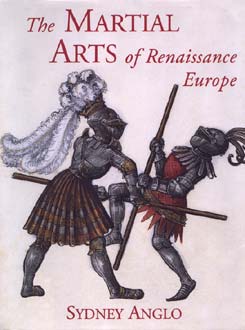The Martial Arts of Renaissance Europe
by Sydney Anglo
Yale University Press, $45
ISBN: 0-300-08352-1
Review by Ken Mondschein, FightingArts.com Staff
 Miyamato Musashi is well known amongst martial artists
as a great swordsman of sixteenth- and seventeenth-
century Japan, but how many have ever heard of his
Italian contemporary, Ridolfo Capo Ferro? For those
with an interest in the European counterparts to kenjutsu,
jujutsu, and the other warrior arts of Japan, "The
Martial Arts of Renaissance Europe" by Sydney
Anglo is well worth picking up. Though suffering somewhat
from a lack of perspective, the book still provides
a good overview of European fighting systems as they
existed from the late Middle Ages to early modern
times, and as their teaching and practice related
to society at large. Accordingly, while some of those
who have spent years and decades studying fencing
and other Western fighting arts may disagree with
some of Dr. Anglo's conclusions, his book still provides
the general reader with a decent introduction to the
arts of war and self-defense as they existed in early
modern Europe and one view of conclusions to be drawn
from them.
Miyamato Musashi is well known amongst martial artists
as a great swordsman of sixteenth- and seventeenth-
century Japan, but how many have ever heard of his
Italian contemporary, Ridolfo Capo Ferro? For those
with an interest in the European counterparts to kenjutsu,
jujutsu, and the other warrior arts of Japan, "The
Martial Arts of Renaissance Europe" by Sydney
Anglo is well worth picking up. Though suffering somewhat
from a lack of perspective, the book still provides
a good overview of European fighting systems as they
existed from the late Middle Ages to early modern
times, and as their teaching and practice related
to society at large. Accordingly, while some of those
who have spent years and decades studying fencing
and other Western fighting arts may disagree with
some of Dr. Anglo's conclusions, his book still provides
the general reader with a decent introduction to the
arts of war and self-defense as they existed in early
modern Europe and one view of conclusions to be drawn
from them.
Dr. Anglo introduces us to such people as Pietro
Monte, acquaintance of Leonardo da Vinci and trainer
of the best warriors of Renaissance Italy; Hans Talhoffer,
master of a fifteenth-century system of German swordsmanship
that has been compared in complexity and depth with
Japan's most famous schools of swordsmanship; and
Jeronimo de Carranza, a sixteenth-century Spanish
nobleman whose geometrical conceptions of swordsmanship
have passed into legend as the "mysterious circle."
This is fascinating reading for those previously unaware
of the variety and history of European arts.
Anglo addresses various subjects, such as the place
of the fencing master, the teaching of martial arts
in society (a subject perhaps better treated by Arthur
Wise's "Art and History of Personal Combat")
and the pedagogical problems related to the notation
and illustration of movement in combat manuals. His
answers to the latter question are interesting, and
certainly of interest to those who practice and teach
Asian martial arts. He also deals with the use and
practice of such weapons as swords, staff weapons,
knives, bare hands, and mounted combat with swords
and lances.
However, in today's society, the term "martial
arts" unfortunately all too often means simply
"that which enables one to dispatch any opponent
quickly and efficiently." Whereas there is a
growing awareness that there is much greater depth
and beauty to the martial arts than mere kicking,
punching, and bone-breaking, some of Dr. Anglo's conclusions
seem to have been fueled by this popular modern misconception,
without specific reference to the norms of Renaissance
Europe. For instance, in his final chapter on "duels,
brawls, and battles," Dr. Anglo seems to say
that there is indeed little difference between the
three scenarios, and compares the civilian martial
art of rapier fencing to commando-style "all-in
fighting." Regardless of the fact that the true
intention of the skillful use of the rapier is to
keep the adversary at distance and kill him there,
this attitude is contrary to some of the best thinking
on the subject. J. Christoph Amberger has pointed
out in his "Secret History of the Sword"
that there is a definite difference between combat
in war and personal combat fought under a set of rules,
and between mass combat and the predatory, cold-blooded
dispatching of an adversary. Perhaps a study of hopology,
or a perusal of Donn Draeger's works, would have stood
Dr. Anglo in good stead.
Still, read with an open mind, "The Martial
Arts of Renaissance Europe" is a good read, and
a useful introduction to the subject.
return
to reviews

back
to top
home
| about
us | magazine
| learning
| connections
| estore
|